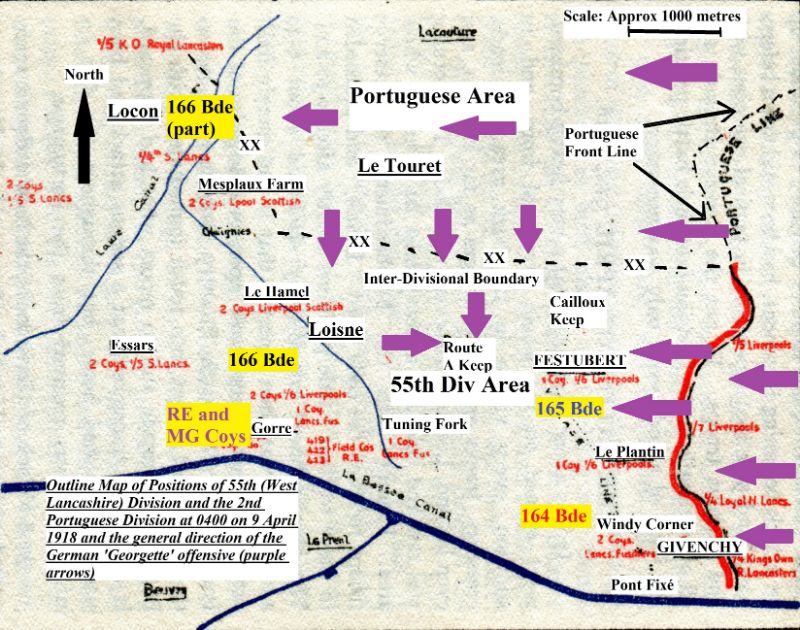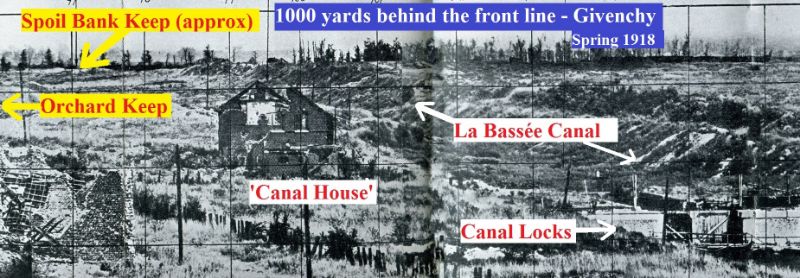This Most Gallant Defence …
Outflanked, the 55th (West Lancashire) Division Stands Fast at Givenchy in 1918
Ian Riley, Liverpool Scottish Regimental Museum Trust
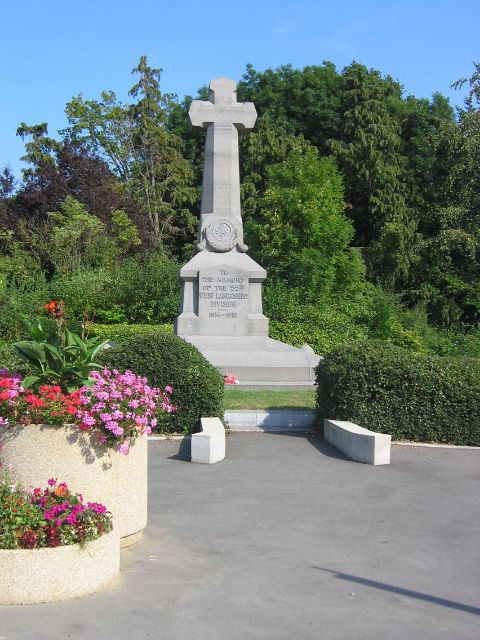
1918 was when the Great War on the Western Front moved from static to mobile. The last major German efforts, Operations ‘Michael’ and ‘Georgette’ in spring 1918, attempted to resolve the war before the United States fully deployed. In March 1918, the BEF, short of men, was pushed back by nearly 30 miles over large sections of its front in the ‘Michael’ offensive. We look at the North-West’s Territorials in early 1918 during the following ‘Georgette’ offensive when the 55th (West Lancashire) Division, commanded by Major-General Hugh Jeudwine, felt the full weight of a three-division assault against an open flank. This was part of the battle that prompted Field Marshal Haig’s ‘Special Order of the Day’:
Every position must be held to the last man: there must be no retirement. With our backs to the wall … each one of us must fight on to the end.
Note:
KORLR: King’s Own (Royal Lancaster Regiment) KLR: King’s (Liverpool Regiment)
LF: Lancashire Fusiliers
SLR: The South Lancashire Regiment
LNLR: Loyal North Lancashire Regiment.
1/4 KORLR is therefore 1/4th Battalion, King’s Own (Royal Lancaster Regiment) - 1000 men at full strength [1/4th is said as ‘First Fourth’].
55th Division had three infantry brigades, each of four battalions, 164, 165 and 166 Brigade
An artillery ‘brigade’ was eighteen guns commanded by a lieutenant-colonel. All quotations and citations are paraphrased.
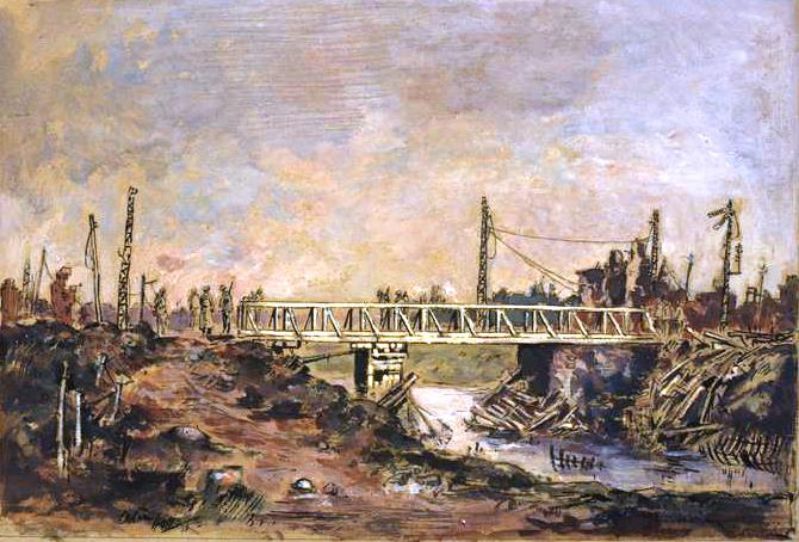 An RE bridge across the La Bassée Canal in 1918. The canal, a substantial obstacle even when drained, formed the right flank of the 55th Division. On 9 April 1918, enemy infiltrated almost 2000 metres along the north bank before being driven off or captured. The sappers fought as infantry. (Artist: Adrian Hill 1918, © IWM Art954)
An RE bridge across the La Bassée Canal in 1918. The canal, a substantial obstacle even when drained, formed the right flank of the 55th Division. On 9 April 1918, enemy infiltrated almost 2000 metres along the north bank before being driven off or captured. The sappers fought as infantry. (Artist: Adrian Hill 1918, © IWM Art954)
A Rehearsed Defence
width="200" height="201" />
‘Georgette’ started on 9th April 1918, striking some 10 to 30 miles south of Ypres (Ieper), threatening the vital Channel port links to the UK and the Béthune coalfields. In April, defences around the villages of Givenchy-lès-Bassée and Festubert, constructed earlier by the 42nd (East Lancashire) Division, were manned by the 55th (West Lancashire) Division. The division’s right flank was the broad La Bassée Canal and on the left flank, to the north, ground was held by a Portuguese division, active allies since 1916. The 55th Division’s training and planning, however, hinted at concerns over the Portuguese defences.
The map to the left shows the initial positions of 55th Division and 2nd Portuguese Division around Givenchy-lès-la-Basée about 0400 on 9 April 1918, immediately before the German attack. The Purple arrows show the attack’s general thrust and the exposed left flank created of the 55th Division (Adapted by author from Coop, Story of the 55th Division)
On its first day, much of the weight of ‘Georgette’ initially fell onto the Portuguese. Although some fought it out, most rapidly fell back to completely expose the left flank of the 55th Division. 
Over the following week, the Givenchy and Festubert defenders gave virtually no ground. The ‘Main Line of Resistance’ was held intact whilst the Division dealt with the open flank where the very real threat to its rear was met by an improvised defence using every man in the division … and more. Intensive planning and rehearsal had left leaders at all levels knowing the ground and with the initiative to counter-attack. Despite signallers making gallant efforts to maintain lines under very heavy fire, it was often the practised and determined runner who delivered the messages. It was a defence involving orderly rooms and cookhouses as well as making infantrymen of Royal Engineers and the Royal Artillery.
The 55th Division deployed with 164 Brigade in a ‘right forward’ position against the Canal near Givenchy and 165 Brigade ‘left forward’ towards Festubert to the north. 166 Brigade was in support to the rear, to move forward on receipt of the codeword ‘Bustle’. Forward troops were given one of two tasks. One was to garrison strong points (often called ‘keeps’) and hold them at all costs. This depended on all ranks understanding the overall plan and that, if surrounded by infiltrating enemy, relieving counter-attacks would be soon expected, a hard-learnt lesson from Epèhy in November 1917. The other distinct task was counter-attack. The effectiveness of counter-attack depended on speed and therefore on frequent rehearsal in exercises, often supervised by Jeudwine himself, with and without troops. ‘Defence’ no longer meant continuous lines of occupied trenches but relied largely on mutually supporting strongpoints, each garrisoned typically by a platoon (30/40 men) and its Lewis gun (the standard light MG), reinforced perhaps by a medium ‘Vickers’ MG and additional Lewis guns. The Givenchy defence was lengthy and complex: it only possible here give an outline.
The map on the right shows 55th Division positions at midnight 9/10 April 1918 at the end of the first day of the Defence of Givenchy. The left flank exposed by the withdrawal of the division to the north is now covered by a mix of 55th Division units (and others) including Royal Engineers in an infantry rôle. (Adapted by author from ‘Coop’)
Suddenly, through the mist …
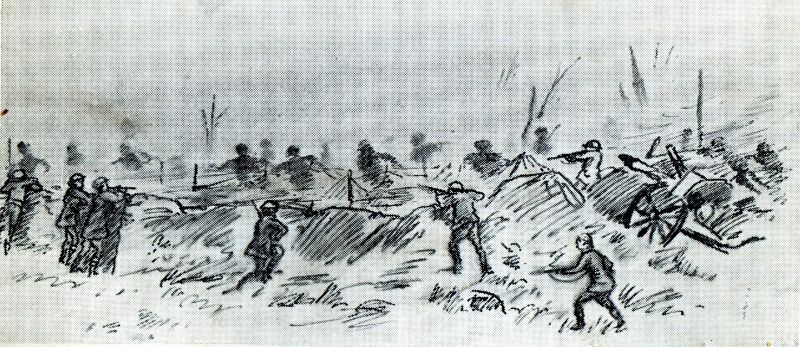
At 4.15 am on 9 April with heavy mist, visibility across the flat ground was only 25 yards. After a devastating artillery barrage fell on the Portuguese, the attack developed rapidly and they withdrew, largely in some disorder. The left flank of the 55th Division was therefore entirely exposed and its rear immediately threatened. 164 Brigade on the right came under very heavy attack, many posts holding out but with enemy parties infiltrating up to 2000 yards along the Canal. Here 2Lt Joseph Collin of Carlisle won a posthumous Victoria Cross with 1/4 KORLR:
After a gallant resistance [at Orchard Keep], Collin, with the last five men of his platoon, made a fighting withdrawal. The enemy closed, engaging with bombs and MGs, but he single-handedly attacked the machine gun with revolver and grenade, putting it out of action. He then engaged a second MG with a Lewis Gun from a high point on the parapet, keeping the enemy at bay until mortally wounded.
Lt John Schofield of Blackburn, with 2/5 LF, also won a posthumous VC in this heavily contested part of the front with 164 Brigade:
Schofield led nine men against a strong-point and was attacked by about 100 of the enemy but, skilfully using men and weapons, he took 20 prisoners. Towards the front line, they engaged a large number of enemy. Climbing onto the parapet under point blank MG fire he forced 123 enemy to surrender but was killed a few minutes later.
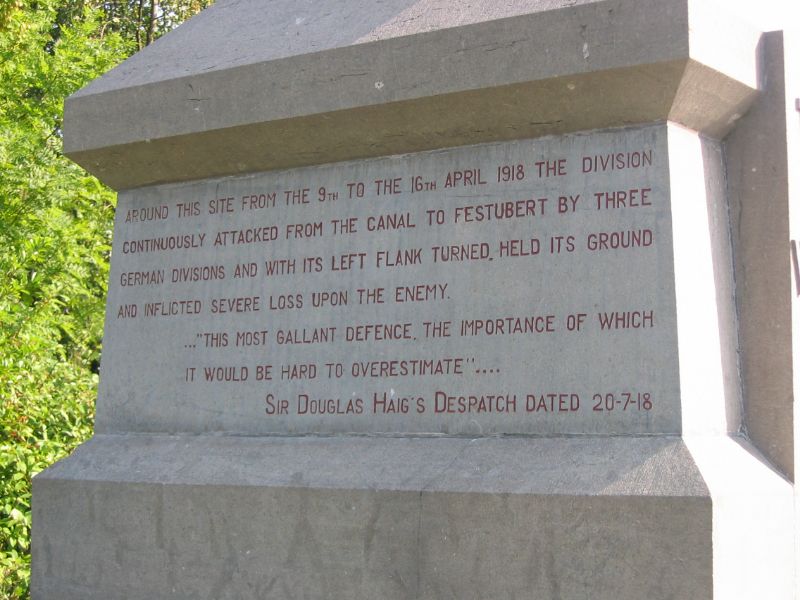
Throughout the day, the other divisional reserve battalions such as Lancaster’s 1/5 KORLR (sent to face Le Touret village to the north), 1/5 SLR of St Helens and 1/10 KLR reinforced the exposed left flank. The detailed tasking was, in part, made possible by local initiative such as the battalion CO who found enemy only 300 yards from artillery batteries but unprotected by infantry and the gutsy determination of signallers and runners such as Private Frederick Coward from Barry and of 1/10 KLR, awarded the Military Medal
Near Loisne (9 April), under heavy shellfire, Private Coward went with a message to find out the situation on the left flank. Going through the barrage, he obtained the information and came back through worse fire, fainting on return but remaining at duty. This performance was repeated on many times over subsequent days.
Gunners and Sappers join the Pioneers as Infantry

Brigades, recently reduced to three infantry battalions, soon ran out of resources even after pitching in the ‘details’, men not normally with rifle companies. Other units were thrown in to extend the improvised flank. Sappers of the Division’s three Royal Engineer Field Companies were committed as infantrymen, joined by the Division’s pioneer battalion, 1/4 SLR from Warrington, to extend the hasty defence. Even further to the left, the weakened 154 Brigade of the 51st (Highland) Division came under 55th Division command to close the open flank. Later, they were joined by 9th Infantry Brigade, including 13 KLR, and some additional artillery. Further back, sappers of 251 Tunnelling Company RE dug in to give additional depth and to bolster those Portuguese still in the battle.
The gunners also had direct dealings with the enemy. Attackers had come within 200 yards of some batteries in action: 18-pounder guns were pulled from their pits to fire at point blank range. In some cases, rifles and Lewis guns were put to use:
All guns of a battery of 276 Brigade RFA had been knocked out and about two officers and 20 men remained. Suddenly through the mist appeared the Hun. The battery commander turned on his Lewis guns and all available rifles – shooting rather wildly but making so much noise that the Boches withdrew 500 yards. [Wadsworth: Account of 275 Brigade RFA]
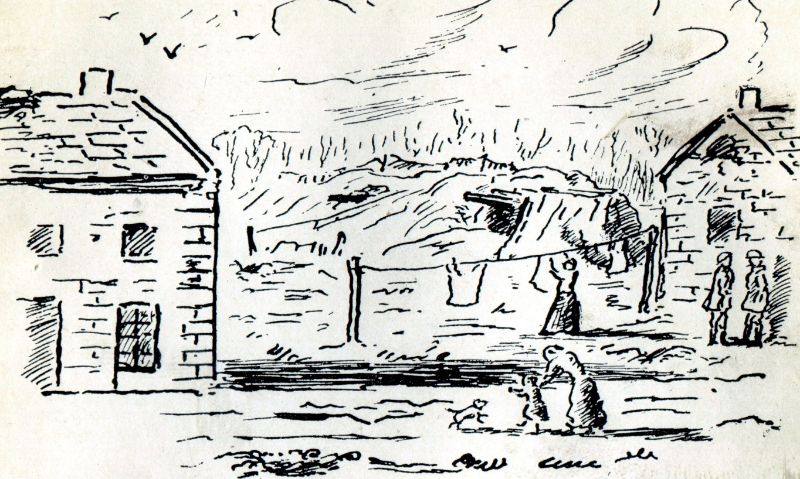
The sketch to the left shows A battery of 275 Brigade (Royal Field Artillery), drawn by its CO (Lt Col Rettie DSO), deployed at the ‘Tuning Fork’ position in the centre of the 55th Division’s defences near Givenchy, spring 1918. The guns are seen between the houses and civilians are still living in the area. (Wadsworth)
Artillerymen with several medium trench mortars fired until the enemy was on top of them and then fought on with rifles. Within the 55th Division, no guns or trench mortars were lost. Lance-Corporal William McGill, of 1/4 KORLR and from Preston, won the Military Medal with 164 Trench Mortar Battery:
Commanding a 3 inch mortar at Givenchy (9 April), and with half his team out of action, as the enemy advanced, LCpl McGill removed the mortar from the pit, dug it in afresh and, ranging on advancing enemy, keeping up rapid fire for 200 rounds.
The 55th Divisional history records that, at the end of the first day of fighting, the Division, assisted by 154 Brigade, held 11,000 yards of front. Practically every rifle of every arm in the Division had been in use. The right brigade (164) was still on its original line and the left brigade (165) still held its Main Line of Resistance, having additionally improvised a flank defence of 2000 yards with 166 Brigade and the Royal Engineers. A substantial number of enemy prisoners and machine guns were captured.
The Battle Continues … ‘This Most Gallant Defence …’
The next two days’ fighting was equally desperate with renewed German attacks of great strength, all either repelled or met with successful counter-attacks.
LCpl Albert Haynes of 1/10 KLR from Preston won the Distinguished Conduct Medal near Festubert (10 April). Surrounded and in hand-to-hand fighting, he showed great gallantry fighting with his bayonet and, when mixed up with the enemy, fought with his fists. He took two MGs from them and brought them back to our position.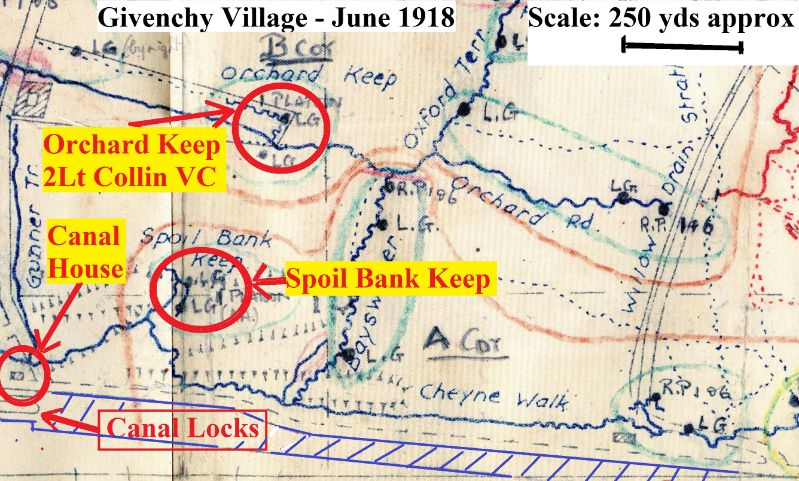
‘Route A Keep’, the important feature on the left flank, was recaptured on 11 April by companies of 1/10 KLR and 13 KLR. Fighting continued until relief on 16 April but 55th Division had to retake ‘Route A Keep’ when it returned to the line towards the end of the month. Although not part of the ‘Defence of Givenchy’, mention should be made of the VC awarded to Lance-Corporal James Hewitson (1/4 KORLR) in a raid on crater posts held by the Germans near Givenchy (28 April), personally accounting for at least 18 of the enemy and an MG.
The Division’s casualties from 9 to 17 April amounted to 163 officers and 2956 ORs killed, missing or wounded (of which 1404 were reported killed or missing by 17 April 1918). The casualty rate of infantry was approximately 33%.
The Commander-in-Chief’s despatch of July 1918 stated:
The success of this most gallant defence, the importance of which would be hard to over-estimate, was due in great measure to the courage and determination displayed by our advanced posts.
The highlighted words stand today on the 55th Division Memorial at Givenchy, beautifully maintained by the village.
Acknowledgements:
Kevin Shannon, Historian of the TF Battalions, King’s Own (Royal Lancaster Regiment)
Stephen Lingard, Historian of the 1/5th Bn, The South Lancashire Regiment TF
John Archer, who has walked the battlefield with me.
Further Reading:
Official History of the War – France and Belgium 1918 Volume 1
A.M. McGilchrist, The Liverpool Scottish 1900-1919
The Jeudwine Papers: FIF 356 Liverpool Record Office
J.O.Coop, The Story of the 55th Division 1916-19
Kevin Shannon, The Lion and the Rose, Vol 1 and Vol 2: 1/4th and 1st/5th Bns., King’s Own (Royal Lancaster Regiment)
W.W. Wadsworth, War Diary of the 1st West Lancashire Brigade, RFA
Chris Baker, The Battle for Flanders: German Defeat on the Lys 1918
Previous page: Triumph and Disaster – Autumn 1917
Next page: ‘Go One Better’ – Fighting to the Finish in 1918
